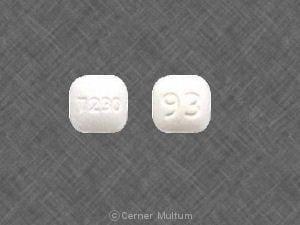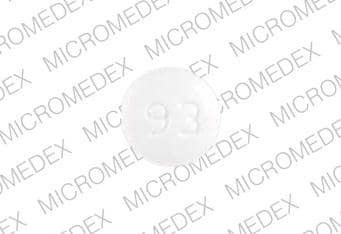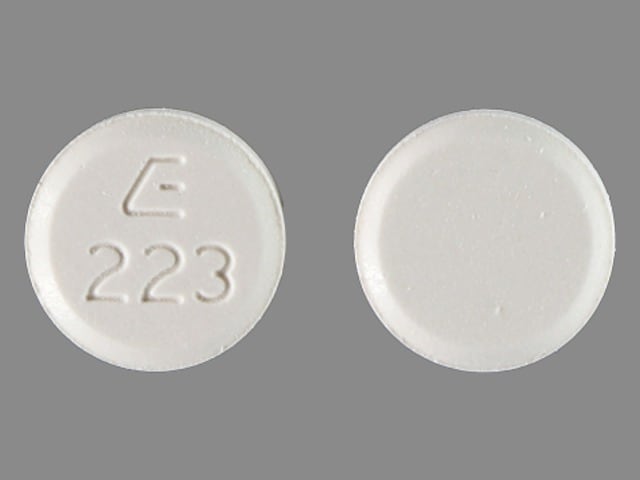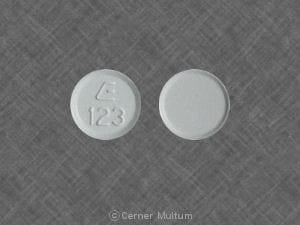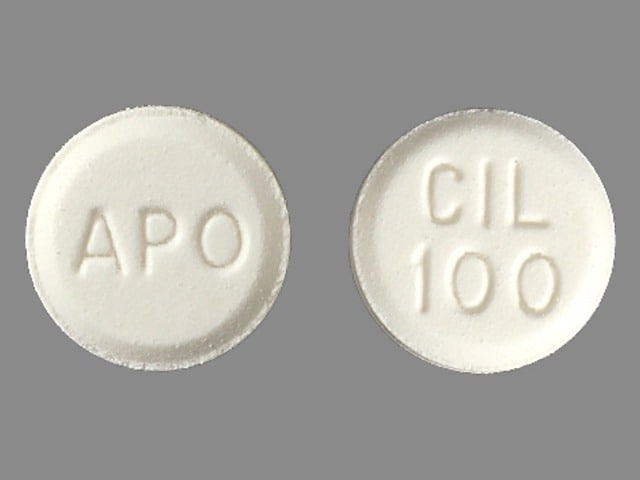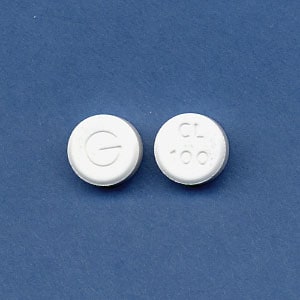Boxed Warning
Contraindicated in heart failure patients:
Cilostazol is contraindicated with patients with heart failure of any severity. Cilostazol and several of its metabolites are inhibitors of phosphodiesterase III. Several drugs with this pharmacologic effect have caused decreased survival compared with placebo in patients with class III to IV heart failure.
Dosage Forms
Excipient information presented when available (limited, particularly for generics); consult specific product labeling.
Tablet, Oral:
Generic: 50 mg, 100 mg
Pharmacology
Mechanism of Action
Cilostazol and its metabolites are inhibitors of phosphodiesterase III. As a result, cyclic AMP is increased leading to reversible inhibition of platelet aggregation, vasodilation, and inhibition of vascular smooth muscle cell proliferation.
Pharmacokinetics/Pharmacodynamics
Metabolism
Hepatic; CYP1A2 (minor), CYP2C19 (major), CYP2D6 (minor), CYP3A4 (major)
Excretion
Urine (74%) and feces (20%) as metabolites
Onset of Action
Effect on walking distance: 2 to 4 weeks; may require up to 12 weeks
Half-Life Elimination
~11 to 13 hours
Protein Binding
Cilostazol 95% to 98%; active metabolites 66% to 97%
Use in Specific Populations
Special Populations: Renal Function Impairment
Severe renal impairment increases metabolite concentrations and alters protein binding of the parent drug.
Special Populations Note
Cigarette smoking: Exposure is decreased by ~20% in smokers.
Use: Labeled Indications
Intermittent claudication: Reduction of symptoms of intermittent claudication, as indicated by an increased walking distance.
Use: Off Label
Elective PCI with bare metal or drug eluting stent placement (alternative agent)yes
Based on the American College of Chest Physicians (ACCP) guidelines for antithrombotic therapy, cilostazol is an effective and recommended alternative antithrombotic to either aspirin or clopidogrel in a dual antiplatelet regimen when allergy or drug intolerance to either agent occurs in patients who have undergone elective PCI with bare metal or drug-eluting stent placement.
Secondary prevention of noncardioembolic ischemic stroke or transient ischemic attack (TIA)yes
Based on the American College of Chest Physicians (ACCP) guidelines for antithrombotic therapy, cilostazol is an effective and recommended alternative antithrombotic in patients with a history of noncardioembolic ischemic stroke or TIA.
Contraindications
Hypersensitivity to cilostazol or any component of the formulation; heart failure of any severity.
Dosage and Administration
Dosing: Adult
Intermittent claudication: Oral: 100 mg twice daily. Note: The American College of Chest Physicians recommends use when refractory to exercise therapy and smoking cessation; use in combination with either aspirin or clopidogrel (ACCP [Guyatt 2012]).
Note: Discontinue treatment if symptoms are not improved after 3 months of therapy.
PCI (following elective stent placement) (off-label use): Oral: 100 mg twice daily in combination with aspirin or clopidogrel. Note: Only recommended in patients with an allergy or intolerance to either aspirin or clopidogrel (ACCP [Guyatt 2012]).
Secondary prevention of noncardioembolic stroke or TIA (off-label use): Oral: 100 mg twice daily. Note: Clopidogrel or aspirin/extended release dipyridamole recommended over the use of cilostazol (ACCP [Guyatt 2012]).
Dosage adjustment with concomitant medications:
CYP2C19 inhibitors (eg, fluconazole, omeprazole, ticlopidine): Reduce cilostazol to 50 mg twice daily.
Strong or moderate CYP3A4 inhibitors (eg, diltiazem, erythromycin, itraconazole, ketoconazole): Reduce cilostazol to 50 mg twice daily.
Dosing: Geriatric
Refer to adult dosing.
Administration
Oral: Administer 30 minutes before or 2 hours after meals (breakfast and dinner).
Storage
Store at 25°C (77°F); excursions permitted to 15°C and 30°C (59°F and 86°F).
Cilostazol Images
Drug Interactions
Acalabrutinib: May enhance the antiplatelet effect of Agents with Antiplatelet Properties. Monitor therapy
Agents with Antiplatelet Properties (e.g., P2Y12 inhibitors, NSAIDs, SSRIs, etc.): May enhance the antiplatelet effect of other Agents with Antiplatelet Properties. Monitor therapy
Anagrelide: May enhance the adverse/toxic effect of Cilostazol. Avoid combination
Anticoagulants: Agents with Antiplatelet Properties may enhance the anticoagulant effect of Anticoagulants. Exceptions: Bemiparin; Enoxaparin; Heparin. Monitor therapy
Apixaban: Agents with Antiplatelet Properties may enhance the adverse/toxic effect of Apixaban. Specifically, the risk for bleeding may be increased. Management: Carefully consider risks and benefits of this combination and monitor closely. Monitor therapy
ARIPiprazole: CYP3A4 Inhibitors (Weak) may increase the serum concentration of ARIPiprazole. Management: Monitor for increased aripiprazole pharmacologic effects. Aripiprazole dose adjustments may or may not be required based on concomitant therapy and/or indication. Consult full interaction monograph for specific recommendations. Monitor therapy
Bemiparin: Agents with Antiplatelet Properties may enhance the anticoagulant effect of Bemiparin. Management: Avoid concomitant use of bemiparin with antiplatelet agents. If concomitant use is unavoidable, monitor closely for signs and symptoms of bleeding. Consider therapy modification
Bosentan: May decrease the serum concentration of CYP3A4 Substrates (High risk with Inducers). Monitor therapy
Cephalothin: Agents with Antiplatelet Properties may enhance the adverse/toxic effect of Cephalothin. Specifically, the risk for bleeding may be increased. Monitor therapy
Cladribine: Inhibitors of Equilibrative Nucleoside (ENT1) and Concentrative Nucleoside (CNT3) Transport Proteins may increase the serum concentration of Cladribine. Management: Avoid concomitant use of ENT1 or CNT3 inhibitors during the 4 to 5 day oral cladribine treatment cycles whenever possible. If combined, consider an ENT1 or CNT3 inhibitor dose reduction and separation in the timing of administration. Consider therapy modification
Clofazimine: May increase the serum concentration of CYP3A4 Substrates (High risk with Inhibitors). Monitor therapy
Collagenase (Systemic): Agents with Antiplatelet Properties may enhance the adverse/toxic effect of Collagenase (Systemic). Specifically, the risk of injection site bruising and/or bleeding may be increased. Monitor therapy
Conivaptan: May increase the serum concentration of CYP3A4 Substrates (High risk with Inhibitors). Avoid combination
CYP2C19 Inhibitors (Moderate): May increase serum concentrations of the active metabolite(s) of Cilostazol. CYP2C19 Inhibitors (Moderate) may increase the serum concentration of Cilostazol. Management: Reduce the cilostazol dose to 50 mg twice daily in patients who are also receiving moderate inhibitors of CYP2C19. Monitor clinical response to cilostazol closely. Consider therapy modification
CYP2C19 Inhibitors (Strong): May increase serum concentrations of the active metabolite(s) of Cilostazol. CYP2C19 Inhibitors (Strong) may increase the serum concentration of Cilostazol. Management: Reduce the cilostazol dose to 50 mg twice daily in patients who are also receiving strong inhibitors of CYP2C19. Monitor clinical response to cilostazol closely. Consider therapy modification
CYP3A4 Inducers (Moderate): May decrease the serum concentration of CYP3A4 Substrates (High risk with Inducers). Monitor therapy
CYP3A4 Inducers (Strong): May increase the metabolism of CYP3A4 Substrates (High risk with Inducers). Management: Consider an alternative for one of the interacting drugs. Some combinations may be specifically contraindicated. Consult appropriate manufacturer labeling. Consider therapy modification
CYP3A4 Inhibitors (Moderate): May increase the serum concentration of Cilostazol. Management: Consider reducing the cilostazol dose to 50 mg twice daily in adult patients who are also receiving moderate inhibitors of CYP3A4. Consider therapy modification
CYP3A4 Inhibitors (Strong): May increase the serum concentration of Cilostazol. Management: Consider reducing the cilostazol dose to 50 mg twice daily in adult patients who are also receiving strong inhibitors of CYP3A4. Consider therapy modification
Dabigatran Etexilate: Agents with Antiplatelet Properties may enhance the anticoagulant effect of Dabigatran Etexilate. Agents with Antiplatelet Properties may increase the serum concentration of Dabigatran Etexilate. This mechanism applies specifically to clopidogrel. Management: Carefully consider risks and benefits of this combination and monitor closely; Canadian labeling recommends avoiding prasugrel or ticagrelor. Monitor therapy
Dabrafenib: May decrease the serum concentration of CYP3A4 Substrates (High risk with Inducers). Management: Seek alternatives to the CYP3A4 substrate when possible. If concomitant therapy cannot be avoided, monitor clinical effects of the substrate closely (particularly therapeutic effects). Consider therapy modification
Dasatinib: May enhance the anticoagulant effect of Agents with Antiplatelet Properties. Management: Drugs listed as exceptions to this monograph are discussed in further detail in separate drug interaction monographs. Monitor therapy
Deferasirox: May decrease the serum concentration of CYP3A4 Substrates (High risk with Inducers). Monitor therapy
Deoxycholic Acid: Agents with Antiplatelet Properties may enhance the adverse/toxic effect of Deoxycholic Acid. Specifically, the risk for bleeding or bruising in the treatment area may be increased. Monitor therapy
Dofetilide: CYP3A4 Inhibitors (Weak) may increase the serum concentration of Dofetilide. Monitor therapy
Edoxaban: Agents with Antiplatelet Properties may enhance the adverse/toxic effect of Edoxaban. Specifically, the risk of bleeding may be increased. Monitor therapy
Enoxaparin: Agents with Antiplatelet Properties may enhance the anticoagulant effect of Enoxaparin. Management: Discontinue antiplatelet agents prior to initiating enoxaparin whenever possible. If concomitant administration is unavoidable, monitor closely for signs and symptoms of bleeding. Consider therapy modification
Enzalutamide: May decrease the serum concentration of CYP3A4 Substrates (High risk with Inducers). Management: Concurrent use of enzalutamide with CYP3A4 substrates that have a narrow therapeutic index should be avoided. Use of enzalutamide and any other CYP3A4 substrate should be performed with caution and close monitoring. Consider therapy modification
Erdafitinib: May decrease the serum concentration of CYP3A4 Substrates (High risk with Inducers). Monitor therapy
Erdafitinib: May increase the serum concentration of CYP3A4 Substrates (High risk with Inhibitors). Monitor therapy
Esomeprazole: May increase serum concentrations of the active metabolite(s) of Cilostazol. Esomeprazole may increase the serum concentration of Cilostazol. Monitor therapy
Fat Emulsion (Fish Oil Based): May enhance the adverse/toxic effect of Agents with Antiplatelet Properties. Monitor therapy
Flibanserin: CYP3A4 Inhibitors (Weak) may increase the serum concentration of Flibanserin. Monitor therapy
Fosaprepitant: May increase the serum concentration of CYP3A4 Substrates (High risk with Inhibitors). Monitor therapy
Fusidic Acid (Systemic): May increase the serum concentration of CYP3A4 Substrates (High risk with Inhibitors). Avoid combination
Glucosamine: May enhance the antiplatelet effect of Agents with Antiplatelet Properties. Monitor therapy
Heparin: Agents with Antiplatelet Properties may enhance the anticoagulant effect of Heparin. Management: Decrease the dose of heparin or agents with antiplatelet properties if coadministration is required. Consider therapy modification
Herbs (Anticoagulant/Antiplatelet Properties) (eg, Alfalfa, Anise, Bilberry): May enhance the adverse/toxic effect of Agents with Antiplatelet Properties. Bleeding may occur. Management: Avoid combination when possible. If used, monitor more closely for evidence of bleeding. Discontinue herbal products with anticoagulant or antiplatelet actions 2 weeks prior to surgical, dental, or invasive procedures. Consider therapy modification
Ibritumomab Tiuxetan: Agents with Antiplatelet Properties may enhance the adverse/toxic effect of Ibritumomab Tiuxetan. Both agents may contribute to impaired platelet function and an increased risk of bleeding. Monitor therapy
Ibrutinib: May enhance the adverse/toxic effect of Agents with Antiplatelet Properties. Monitor therapy
Idelalisib: May increase the serum concentration of CYP3A4 Substrates (High risk with Inhibitors). Avoid combination
Inotersen: May enhance the antiplatelet effect of Agents with Antiplatelet Properties. Monitor therapy
Ivosidenib: May decrease the serum concentration of CYP3A4 Substrates (High risk with Inducers). Monitor therapy
Larotrectinib: May increase the serum concentration of CYP3A4 Substrates (High risk with Inhibitors). Monitor therapy
Lemborexant: CYP3A4 Inhibitors (Weak) may increase the serum concentration of Lemborexant. Management: The maximum recommended dosage of lemborexant is 5 mg, no more than once per night, when coadministered with weak CYP3A4 inhibitors. Consider therapy modification
Limaprost: May enhance the antiplatelet effect of Agents with Antiplatelet Properties. Monitor therapy
Lomitapide: CYP3A4 Inhibitors (Weak) may increase the serum concentration of Lomitapide. Management: Patients on lomitapide 5 mg/day may continue that dose. Patients taking lomitapide 10 mg/day or more should decrease the lomitapide dose by half. The lomitapide dose may then be titrated up to a max adult dose of 30 mg/day. Consider therapy modification
Lorlatinib: May decrease the serum concentration of CYP3A4 Substrates (High risk with Inducers). Management: Avoid concurrent use of lorlatinib with any CYP3A4 substrates for which a minimal decrease in serum concentrations of the CYP3A4 substrate could lead to therapeutic failure and serious clinical consequences. Consider therapy modification
MiFEPRIStone: May increase the serum concentration of CYP3A4 Substrates (High risk with Inhibitors). Management: Minimize doses of CYP3A4 substrates, and monitor for increased concentrations/toxicity, during and 2 weeks following treatment with mifepristone. Avoid cyclosporine, dihydroergotamine, ergotamine, fentanyl, pimozide, quinidine, sirolimus, and tacrolimus. Consider therapy modification
Mitotane: May decrease the serum concentration of CYP3A4 Substrates (High risk with Inducers). Management: Doses of CYP3A4 substrates may need to be adjusted substantially when used in patients being treated with mitotane. Consider therapy modification
Multivitamins/Fluoride (with ADE): May enhance the antiplatelet effect of Agents with Antiplatelet Properties. Monitor therapy
Multivitamins/Minerals (with ADEK, Folate, Iron): May enhance the antiplatelet effect of Agents with Antiplatelet Properties. Monitor therapy
Multivitamins/Minerals (with AE, No Iron): May enhance the antiplatelet effect of Agents with Antiplatelet Properties. Monitor therapy
NiMODipine: CYP3A4 Inhibitors (Weak) may increase the serum concentration of NiMODipine. Monitor therapy
Obinutuzumab: Agents with Antiplatelet Properties may enhance the adverse/toxic effect of Obinutuzumab. Specifically, the risk of serious bleeding-related events may be increased. Monitor therapy
Omega-3 Fatty Acids: May enhance the antiplatelet effect of Agents with Antiplatelet Properties. Monitor therapy
Omeprazole: May increase serum concentrations of the active metabolite(s) of Cilostazol. Omeprazole may increase the serum concentration of Cilostazol. Management: Reduce the cilostazol dose to 50 mg twice daily in patients who are also receiving omeprazole. Monitor clinical response to cilostazol closely. Consider therapy modification
Palbociclib: May increase the serum concentration of CYP3A4 Substrates (High risk with Inhibitors). Monitor therapy
Pentosan Polysulfate Sodium: May enhance the adverse/toxic effect of Agents with Antiplatelet Properties. Specifically, the risk of bleeding may be increased by concurrent use of these agents. Monitor therapy
Pentoxifylline: May enhance the antiplatelet effect of Agents with Antiplatelet Properties. Monitor therapy
Pimozide: CYP3A4 Inhibitors (Weak) may increase the serum concentration of Pimozide. Avoid combination
Prostacyclin Analogues: May enhance the antiplatelet effect of Agents with Antiplatelet Properties. Monitor therapy
Riociguat: Cilostazol may enhance the hypotensive effect of Riociguat. Management: Riociguat is contraindicated with nonselective phosphodiesterase (PDE) inhibitors and PDE type 5 inhibitors. Other types of PDE inhibitors are not contraindicated, but caution is advised and patients should be monitored for hypotension. Monitor therapy
Rivaroxaban: Agents with Antiplatelet Properties may enhance the anticoagulant effect of Rivaroxaban. Management: Carefully consider risks and benefits of this combination and monitor closely; Canadian labeling recommends avoiding prasugrel or ticagrelor. Monitor therapy
Salicylates: Agents with Antiplatelet Properties may enhance the adverse/toxic effect of Salicylates. Increased risk of bleeding may result. Monitor therapy
Sarilumab: May decrease the serum concentration of CYP3A4 Substrates (High risk with Inducers). Monitor therapy
Siltuximab: May decrease the serum concentration of CYP3A4 Substrates (High risk with Inducers). Monitor therapy
Simeprevir: May increase the serum concentration of CYP3A4 Substrates (High risk with Inhibitors). Monitor therapy
Simvastatin: Cilostazol may increase the serum concentration of Simvastatin. Monitor therapy
Stiripentol: May increase the serum concentration of CYP3A4 Substrates (High risk with Inhibitors). Management: Use of stiripentol with CYP3A4 substrates that are considered to have a narrow therapeutic index should be avoided due to the increased risk for adverse effects and toxicity. Any CYP3A4 substrate used with stiripentol requires closer monitoring. Consider therapy modification
Thrombolytic Agents: Agents with Antiplatelet Properties may enhance the anticoagulant effect of Thrombolytic Agents. Monitor therapy
Ticlopidine: May increase serum concentrations of the active metabolite(s) of Cilostazol. Ticlopidine may increase the serum concentration of Cilostazol. Monitor therapy
Tipranavir: May enhance the antiplatelet effect of Agents with Antiplatelet Properties. Monitor therapy
Tocilizumab: May decrease the serum concentration of CYP3A4 Substrates (High risk with Inducers). Monitor therapy
Triazolam: CYP3A4 Inhibitors (Weak) may increase the serum concentration of Triazolam. Management: Consider triazolam dose reduction in patients receiving concomitant weak CYP3A4 inhibitors. Consider therapy modification
Ubrogepant: CYP3A4 Inhibitors (Weak) may increase the serum concentration of Ubrogepant. Management: In patients taking weak CYP3A4 inhibitors, the initial and second dose (if needed) of ubrogepant should be limited to 50 mg. Consider therapy modification
Urokinase: Agents with Antiplatelet Properties may enhance the anticoagulant effect of Urokinase. Avoid combination
Vitamin E (Systemic): May enhance the antiplatelet effect of Agents with Antiplatelet Properties. Monitor therapy
Zanubrutinib: May enhance the antiplatelet effect of Agents with Antiplatelet Properties. Monitor therapy
Adverse Reactions
>10%:
Central nervous system: Headache (27% to 34%)
Gastrointestinal: Diarrhea (12% to 19%), abnormal stools (12% to 15%)
Infection: Infection (10% to 14%)
Respiratory: Rhinitis (7% to 12%)
1% to 10%:
Cardiovascular: Palpitations (5% to 10%), peripheral edema (7% to 9%), tachycardia (4%), atrial fibrillation (<2%), atrial flutter (<2%), cardiac arrest (<2%), cardiac failure (<2%), cerebral infarction (<2%), edema (<2%), facial edema (<2%), hypotension (<2%), myocardial infarction (<2%), nodal arrhythmia (<2%), orthostatic hypotension (<2%), supraventricular tachycardia (<2%), syncope (<2%), varicose veins (<2%), ventricular premature contractions (<2%), ventricular tachycardia (<2%)
Central nervous system: Dizziness (9% to 10%), vertigo (3%), anxiety (<2%), chills (<2%), insomnia (<2%), malaise (<2%), neuralgia (<2%)
Dermatologic: Ecchymoses (<2%), furunculosis (eye: <2%), skin hypertrophy (<2%), urticaria (<2%), xeroderma (<2%)
Endocrine & metabolic: Albuminuria (<2%), diabetes mellitus (<2%), gout (<2%), hyperlipidemia (<2%), hyperuricemia (<2%), increased gamma-glutamyl transferase (<2%)
Gastrointestinal: Nausea (7%), dyspepsia (6%), abdominal pain (4% to 5%), flatulence (3%), anorexia (<2%), cholelithiasis (<2%), colitis (<2%), duodenal ulcer (<2%), duodenitis (<2%), esophageal hemorrhage (<2%), esophagitis (<2%), gastric ulcer (<2%), gastritis (<2%), gastroenteritis (<2%), gingival hemorrhage (<2%), hematemesis (<2%), melena (<2%), peptic ulcer (<2%), periodontal abscess (<2%)
Genitourinary: Cystitis (<2%), pelvic pain (<2%), urinary frequency (<2%), vaginal hemorrhage (<2%), vaginitis (<2%)
Hematologic & oncologic: Anemia (<2%), hemorrhage (<2%), hemorrhage (eye, <2%), iron deficiency anemia (<2%), polycythemia (<2%), purpura (<2%), rectal hemorrhage (<2%), retroperitoneal hemorrhage (<2%)
Hypersensitivity: Tongue edema (<2%)
Neuromuscular & skeletal: Back pain (7%), myalgia (3%), arthralgia (<2%), bursitis (<2%), neck stiffness (<2%), ostealgia (<2%)
Ophthalmic: Amblyopia (<2%), blindness (<2%), conjunctivitis (<2%), diplopia (<2%), retinal hemorrhage (<2%)
Otic: Otalgia (<2%), tinnitus (<2%)
Renal: Increased serum creatinine (<2%)
Respiratory: Pharyngitis (10%), cough (3% to 4%), asthma (<2%), epistaxis (<2%), hemoptysis (<2%), pneumonia (<2%), sinusitis (<2%)
Miscellaneous: Fever (<2%)
Postmarketing and/or case reports: Abnormal hepatic function tests, agranulocytosis, anaphylaxis, angina pectoris, angioedema, aplastic anemia, cerebrovascular accident, cerebral hemorrhage, chest pain, coronary thrombosis (stent), fixed drug eruption, gastrointestinal hemorrhage, granulocytopenia, hematoma (extradural), hematuria, hemorrhagic diathesis, hepatic insufficiency, hot flash, hyperglycemia, hypersensitivity, hypertension, increased blood pressure, increased blood urea nitrogen, interstitial pneumonitis, intracranial hemorrhage, jaundice, left ventricular dysfunction (outflow tract obstruction; in patients with sigmoid-shaped interventricular septum), leukopenia, pain, pancytopenia, pulmonary hemorrhage, pruritus, prolonged Q-T interval on ECG, skin rash, Stevens-Johnson syndrome, subcutaneous hemorrhage, subdural hematoma, thrombocytopenia, thrombosis, torsades de pointes, vasodilation, vomiting
Warnings/Precautions
Concerns related to adverse effects:
- Cardiovascular effects: May induce tachycardia, palpitation, tachyarrhythmia, and/or hypotension. Left ventricular outflow tract obstruction has been reported in patients with sigmoid shaped interventricular septum; monitor for the development of a new systolic murmur or cardiac symptoms after initiating therapy.
- Hematologic effects: Cases of thrombocytopenia or leukopenia progressing to agranulocytosis, reversible upon discontinuation, have been reported when not immediately discontinued; monitor platelets and white blood cell counts periodically.
Disease-related concerns:
- Hemostatic disorders: Avoid use in patients with active pathological bleeding or hemostatic disorders (has not been studied).
- Cardiovascular disease: [US Boxed Warning]: Cilostazol is contraindicated in patients with heart failure of any severity. Phosphodiesterase inhibitors have caused decreased survival compared with placebo in patients with class III to IV heart failure. Patients with history of ischemic heart disease may be at increased risk for exacerbation of angina pectoris or myocardial infarction.
- Hepatic impairment: Use with caution in patients with moderate to severe hepatic impairment (has not been studied).
- Renal impairment: Use with caution in patients with severe renal impairment.
Concurrent drug therapy issues:
- Drug-drug interactions: Potentially significant interactions may exist, requiring dose or frequency adjustment, additional monitoring, and/or selection of alternative therapy. Consult drug interactions database for more detailed information.
Other warnings/precautions:
- Elective surgery: Time required to recover adequate platelet function is ~2 days (Hill 2011). Of note, bleeding times were not significantly altered by cilostazol after 3 to 14 days of treatment (Kim 2004; Wilhite 2003).
Monitoring Parameters
Platelets and WBC counts periodically; monitor for the development of a new systolic murmur or cardiac symptoms.
Pregnancy
Pregnancy Risk Factor
C
Pregnancy Considerations
Adverse events have been observed in animal reproduction studies.
Patient Education
What is this drug used for?
- It is used to ease pain, numbness, and tingling in the legs.
- It may be given to you for other reasons. Talk with the doctor.
Frequently reported side effects of this drug
- Dizziness
- Headache
- Diarrhea
- Abnormal stools
- Nausea
- Abdominal pain
- Sore throat
- Runny nose
Other side effects of this drug: Talk with your doctor right away if you have any of these signs of:
- Bleeding like vomiting blood or vomit that looks like coffee grounds; coughing up blood; blood in the urine; black, red, or tarry stools; bleeding from the gums; abnormal vaginal bleeding; bruises without a reason or that get bigger; or any severe or persistent bleeding.
- Infection
- Chest pain
- Severe dizziness
- Passing out
- Fast heartbeat
- Abnormal heartbeat
- Swelling of arms or legs
- Signs of a significant reaction like wheezing; chest tightness; fever; itching; bad cough; blue skin color; seizures; or swelling of face, lips, tongue, or throat.
Note: This is not a comprehensive list of all side effects. Talk to your doctor if you have questions.
Consumer Information Use and Disclaimer: This information should not be used to decide whether or not to take this medicine or any other medicine. Only the healthcare provider has the knowledge and training to decide which medicines are right for a specific patient. This information does not endorse any medicine as safe, effective, or approved for treating any patient or health condition. This is only a brief summary of general information about this medicine. It does NOT include all information about the possible uses, directions, warnings, precautions, interactions, adverse effects, or risks that may apply to this medicine. This information is not specific medical advice and does not replace information you receive from the healthcare provider. You must talk with the healthcare provider for complete information about the risks and benefits of using this medicine.
